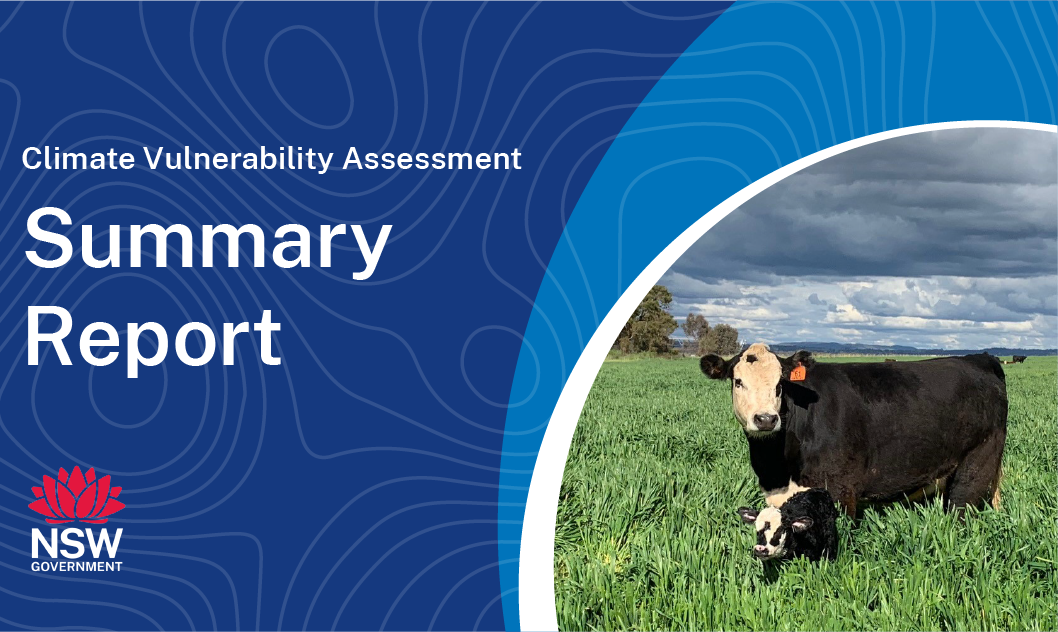What is the NSW DPI Climate Vulnerability Assessment? ⏷
Climate change is altering the growing conditions for many commodities across NSW. Primary producers need evidence-based information about the changing climate, and the risks and opportunities it may bring.
The NSW DPI Climate Vulnerability Assessments are enhancing the resilience of our primary industries by providing information and data to help the sector better plan for, and respond to, climate change. They have assessed climate change impacts for extensive livestock, broadacre and irrigated cropping, marine fisheries, forestry, horticulture and viticulture, and important biosecurity risks associated with these industries to inform sound planning, risk management and adaptation decisions.
How we assessed climate suitability ⏷
Marine future climate projections were sourced from the World Climate Research Programme, with historical climate data supplied by the Copernicus Marine Environment Monitoring Service. The climate models differ in their projections, giving rise to uncertainty which is reflected in the confidence statements given in brackets in the text. Care should be taken when interpreting these results.
The Climate Vulnerability Assessment is intended to highlight potential industry- or regional-level changes. Intermediate and high emissions scenarios were used in the assessments (RCP4.5 and RCP8.5), but these are not the only future scenarios possible. The inclusion of climate variables important to the commodities production was based on published research, expert knowledge and data quality and availability.
Learn more in the Climate Vulnerability Assessment Project Framework.
Climate impacts: what to expect
Future climate change affects bonito via rising ocean temperatures, resulting in differing seasonal impacts for fisheries in NSW coastal waters:
- Summer – Climate suitability for bonito in summer, which ranges from moderate in northern coastal waters to high in southern waters, is expected to remain at these historical levels in 2050, with minimal negative change expected in the climate suitability for central NSW waters, becoming moderate (high confidence).
- Autumn – During autumn, climate suitability along the entire NSW coast is expected to remain moderate in 2050 (moderate confidence).
- Winter – Historical climate suitability during winter is likely to experience negligible change by 2050, continuing to range from high in northern coastal waters to moderate in southern waters (moderate confidence).
- Spring – Historical climate suitability during spring is likely to remain high to very high in northern coastal waters in 2050. Within central and southern NSW waters, historical climate suitability ranged between moderate and high. Minimal positive change in climate suitability for bonito is projected for these regions by 2050 (high confidence).
Bonito vulnerabilities
- Minimal negative change in climate suitability for bonito is likely in central NSW waters during summer. These changes may lead to reduced fishing opportunities in the Manning Shelf and Hawkesbury Shelf bioregions.
Bonito opportunities
- Climate suitability expected to experience minimal increases during spring in central and southern NSW coastal waters. These increases in climate suitability for bonito may provide greater fishing opportunities in the Manning Shelf, Hawkesbury Shelf, Batemans Shelf and northern Twofold Shelf bioregions in the future.
Adapting to the changing climate
Future changes in fish species distributions and seasonal availability may require adaptation from fisheries industries, such as adjustment of quota shares or changes to the timing of fishing for particular target species. Recreational fishers may see changes within their favoured coastal regions, including opportunities for catching different species.
Where can I find the climate suitability maps?
Maps of historical and future climate suitability for commodities were produced to demonstrate where in the state a commodity is likely to thrive or else be limited by future climatic conditions. The maps are not provided on these webpages but can be found in the Climate Vulnerability Assessment Summary Report (PDF, 41425.92 KB).
Bonito Factsheet
(PDF, 636.35 KB)

Summary Report
(PDF, 41425.92 KB)

 Bonito (Sarda australis) in NSW
Bonito (Sarda australis) in NSW